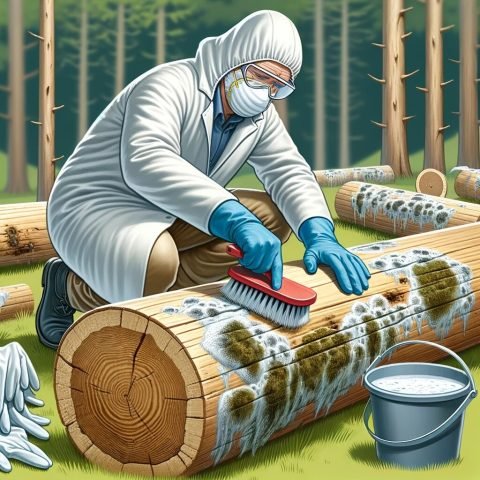Mold on logs can be a significant problem, especially in damp environments.
Not only is it unsightly, but it can also cause structural damage and health issues.
Fortunately, there are effective methods to remove mold from logs, ensuring the longevity and safety of your wooden structures.
Key Takeaways:
- Mold on logs is a common issue in damp environments and requires prompt attention.
- Various methods, including mechanical removal and chemical treatments, are effective in mold removal.
- Regular maintenance and preventive measures can help avoid mold growth on logs.
Understanding Mold on Logs
What is Mold and Why Does it Grow on Logs?
Mold is a type of fungus that thrives in moist environments. Logs, especially in humid conditions or when not properly maintained, provide an ideal breeding ground for mold. Understanding the conditions that lead to mold growth is crucial in preventing its occurrence.
The Impact of Mold on Logs
Mold can cause structural damage to logs by breaking down the wood fibers. This not only weakens the structure but can also lead to costly repairs. Additionally, mold poses health risks, particularly for individuals with allergies or respiratory issues.
Methods for Removing Mold
Mechanical Removal Techniques
Scrubbing and Sanding
One of the most straightforward methods to remove mold from logs is through physical scrubbing and sanding. This method is effective for surface mold and can restore the appearance of the logs.
Blasting Techniques
For more severe cases, techniques like sandblasting or media blasting can be employed. These methods are more aggressive and can remove deeper mold infestations.
Chemical Treatments
Using Bleach Solutions
Bleach is a common chemical used to kill mold. A solution of bleach and water can be applied to the affected areas to eliminate mold growth. However, it’s important to use it cautiously, as bleach can be harsh on wood.
Eco-Friendly Alternatives
For those seeking more environmentally friendly options, vinegar or hydrogen peroxide can be effective alternatives to bleach. These substances are less harsh on the wood and safer for the environment.
Professional Mold Remediation
In cases of extensive mold infestation, professional mold remediation may be necessary. Professionals have the expertise and equipment to safely and effectively remove mold from logs.
Preventive Measures and Maintenance
Regular Inspections
Regular inspections of log structures can help identify mold growth early, making it easier to manage.
Proper Ventilation and Moisture Control
Ensuring adequate ventilation and controlling moisture levels around log structures are key in preventing mold growth.
Use of Sealants and Stains
Applying sealants and stains to logs can provide a barrier against moisture, reducing the likelihood of mold growth.
Mold Removal Case Studies
Table: Before and After Comparisons
| Case | Method Used | Results |
|---|---|---|
| 1 | Scrubbing | Surface mold removed, logs’ appearance improved |
| 2 | Bleach Solution | Deep mold removed, structural integrity preserved |
| 3 | Professional Remediation | Extensive mold eradicated, logs restored to original condition |
Real-Life Success Stories
Hear from individuals who successfully removed mold from their logs, detailing the methods they used and the outcomes they achieved.
Advanced Mold Removal Techniques
Innovative Chemical Treatments
Explore the latest advancements in chemical treatments for mold removal, offering more effective and less harmful options.
Cutting-Edge Mechanical Methods
Discover new mechanical methods being developed for mold removal, which are more efficient and less abrasive to the wood.
Expert Interviews
Gain insights from experts in the field of mold remediation, sharing their knowledge on the most effective techniques and preventive measures.
Advanced Mold Removal Techniques and Maintenance
Continuing from our comprehensive guide on removing mold from logs, this section delves into advanced techniques, maintenance tips, and frequently asked questions to help you effectively tackle mold issues on your logs.
Advanced Mold Removal Techniques
Innovative Chemical Solutions
Exploring New Chemicals
Recent advancements in chemical treatments offer more effective and eco-friendly options for mold removal. Products like RMR-86 have shown promising results in early testing. For more details on innovative chemical solutions, Custom Timber Log Homes provides insightful information.
Cutting-Edge Mechanical Methods
Ultrasonic Cleaning
Ultrasonic cleaning is an emerging technique that uses ultrasonic waves to remove mold from logs. This method is less abrasive and can reach areas that are difficult to clean manually.
Expert Interviews
Insights from Professionals
Gaining insights from professionals in the field can provide valuable knowledge on the most effective mold removal techniques. Interviews with experts can offer a deeper understanding of the complexities involved in mold remediation.
Maintenance and Prevention
Regular Cleaning and Inspection
Importance of Routine Maintenance
Regular cleaning and inspection are crucial in preventing mold growth. This includes checking for leaks, ensuring proper ventilation, and addressing any moisture issues promptly.
Moisture Control Strategies
Effective Moisture Management
Controlling moisture levels around log structures is key to preventing mold. This can involve using dehumidifiers, ensuring proper drainage, and maintaining a dry environment.
Protective Coatings and Sealants
Using Sealants for Prevention
Applying protective coatings and sealants can provide a barrier against moisture, significantly reducing the likelihood of mold growth. It’s important to choose products compatible with your type of logs.
Additional Resources
Further Reading
For more information on wood care and maintenance, explore these articles from StringPulp.com:
Frequently Asked Questions
Common Queries About Mold Removal
Can mold on logs cause health issues?
Yes, mold can cause respiratory issues and allergic reactions. It’s important to address mold growth promptly.
Are natural remedies effective for mold removal?
Natural remedies like vinegar can be effective for mild mold infestations but may not be sufficient for severe cases.
How often should logs be inspected for mold?
Logs should be inspected at least once a year, or more frequently in damp environments.
Additional Questions
Can mold return after removal?
Yes, if the underlying moisture issue is not resolved, mold can return. Ongoing maintenance is crucial.
Is professional mold remediation always necessary?
For extensive or deep-seated mold infestations, professional remediation is recommended to ensure complete removal.

